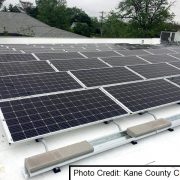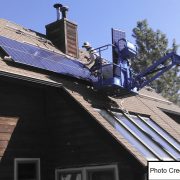By Karla Peterson
June 27, 2017
Read the original article Here
It was a sweltering day in San Diego, and the sun was beating down on the roof of the Oak Park house like the sky had turned its high beams on. It was relentlessly bright and extremely hot. Just like Mohamed Hauter likes it.
Hauter is a volunteer with GRID Alternatives San Diego, the local branch of a national nonprofit that provides solar power to low-income families for a very low fee or no fee at all. At least once a week, Hauter takes a day off from his job as a project leader and software manager at Venator Solutions to help install rooftop solar panels on homes all over San Diego County. He makes up the job time by working weekends. The emotional payoff is more of a 24/7 proposition.
“Oh my gosh, solar energy is just beautiful. There are a lot of bounties in nature, and this is one of them,” the 32-year-old Hauter said, as he took a break from the day’s installation, an all-refugee effort coordinated by the Get Charged Up nonprofit group. “I know people, including my parents, who pay as much for their energy bills as they do for their mortgage. If I can help offset that, I can help make them a lot happier.”
Founded 16 years ago in Oakland, GRID Alternatives set up a San Diego outpost in 2008. Since then, the local branch has installed 842 solar systems and trained more than 2,240 participants through its installation training program. Like many of his fellow volunteers, Hauter came to GRID Alternatives because he wanted to learn more about solar technology. He did not expect the windfall of human perks.
Hauter joined GRID Alternatives in 2014. He quickly became part of the Team Leader Program, which gives participants expanded hands-on training and leadership responsibilities, along with experience that counts toward the National American Board of Certified Energy Practitioners professional installer exam. Hauter is proud to say that he recently received his California Solar Contractor’s license, which brings him closer to starting his own solar business. At this point, he could pack up his hard hat and move on. But he won’t.
“I could have stopped two years ago, and I would have been fine with my training,” said Hauter, who lives in Mira Mesa with his wife and their 2 ½-year-old daughter. “I’m still here because I love it. At the end of the day, when you look at the homeowner’s face as we turn on the system and they see their (electrical meter) going backwards, that means a lot. I grew up poor, so this is important to me.”
One of 10 children, Hauter grew up in Yemen. While it was once the center of civilization on the Arabian peninsula, Yemen is now a war-torn country struggling with extreme poverty and devastating famine. When you are living in the poorest country in the Middle East, it doesn’t take much to make you feel lucky. And by the standards of their homeland, the Hauters were lucky.
Hauter’s father was a farmer who split his time between Yemen and a newsstand he had opened in New York City. The kids didn’t have toys, and they didn’t always have shoes. But they had a roof over their heads and food to eat, and when Hauter was in high school, they had the rare chance to start over in much greener pastures.
In 2002, Hauter and his family moved to Fresno. It was a very good time to be out of Yemen and a terrible time to be a Middle Eastern refugee in the United States.
“It was extremely hard,” said Hauter, who could not speak English when he arrived. “Not because of the language barriers, but more because of all of the racism attached to 9/11. I was bullied a lot, and my name didn’t help. Basically, everyone saw a target on our backs, and they treated us as such. Pretty much all of our neighbors refused to communicate with us. My parents still live there, and they don’t know anyone but two of their neighbors.”
The language barrier fell pretty quickly, as Hauter became fluent in English and began studying computer engineering at Fresno State University. He went to school full time while also working nearly 40 hours a week in his father’s mini-mart. The racial barriers were still an issue, but Hauter and his siblings — most of whom are either college graduates or attending college now — would not be derailed by it.
“We just put our heads down and concentrated on the things that mattered,” Hauter said. “They were rough years, but they paid off.”
He came to San Diego in 2007 to take a job at Lockheed Martin. While he was there, Hauter got his master’s in degree in network engineering through an online program with UC Santa Cruz. When Lockheed closed the San Diego office in 2013, Hauter joined Venator Solutions. Then came GRID Alternatives San Diego and the giving-back light that will not go out.
Last year, the organization gave Hauter the Eugene Tucker Award, which was named after a standout volunteer and bestowed upon people who have followed in his generous footsteps.
“Mohamed is a smart person, and he has a very good way of making abstract concepts simple so that everyone can understand them,” said Laura Galavis, GRID San Diego’s assistant project manager. “He is quiet, but he will give you the information if you are eager to learn. And he is a very good guy. Even though he doesn’t really have to keep volunteering with us, he does. He is our right hand and our left hand. He could probably do the whole job by himself.”
Maybe he could, but he wouldn’t want to. As it turns out, the sun is not the only renewable energy source in Hauter’s life.
“In Fresno, a lot of people die of heat exhaustion because they can’t afford to cool their houses, and that’s sad. I would do anything to help people like that,” Hauter said, as he put on his hard hat and headed back to the roof. “When we came to the United States, we were helped by members of the community. They helped me get to where I am now. It’s my turn to give back.”



